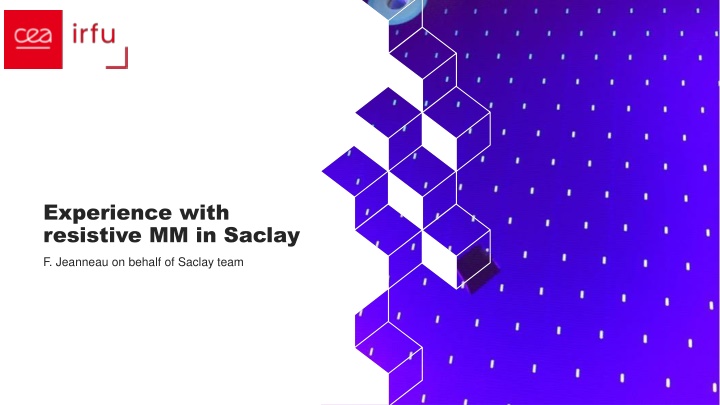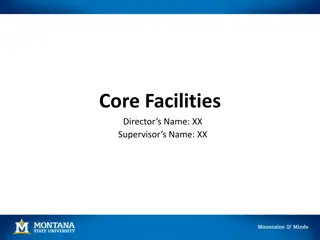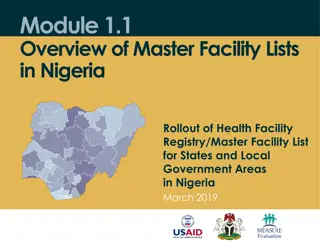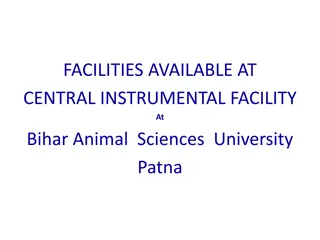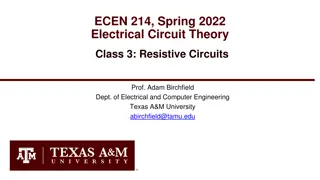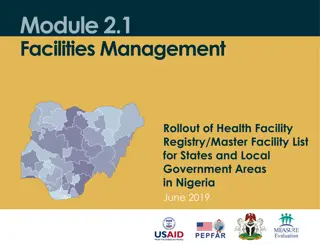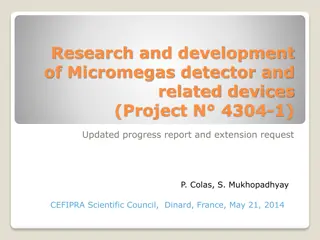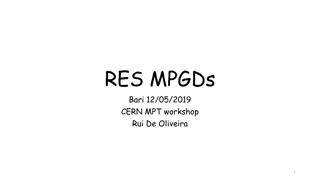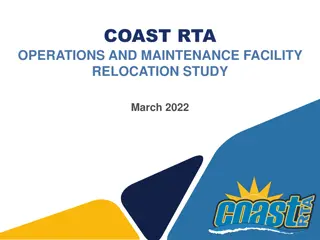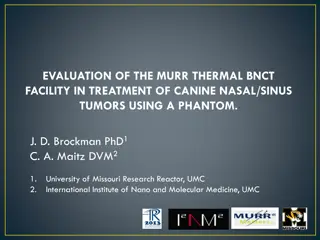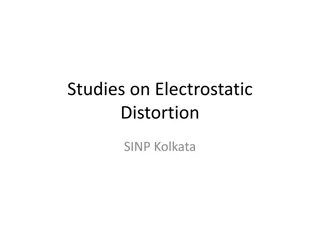Resistive Micromegas Experiments at Saclay Facility
Resistive Micromegas experiments conducted at Saclay, including R&D for spark reduction at PS and SPS, development of detectors with resistive strips, and facility details for bulk processes. Learn about innovative technologies and challenges faced in the research field.
Download Presentation

Please find below an Image/Link to download the presentation.
The content on the website is provided AS IS for your information and personal use only. It may not be sold, licensed, or shared on other websites without obtaining consent from the author.If you encounter any issues during the download, it is possible that the publisher has removed the file from their server.
You are allowed to download the files provided on this website for personal or commercial use, subject to the condition that they are used lawfully. All files are the property of their respective owners.
The content on the website is provided AS IS for your information and personal use only. It may not be sold, licensed, or shared on other websites without obtaining consent from the author.
E N D
Presentation Transcript
Experience with resistive MM in Saclay F. Jeanneau on behalf of Saclay team 1
Experiments with resistive MM in Saclay R&D for spark reduction at PS and SPS for COMPASS and JLAB CLAS12 experiment: barrel and forward detector with resistive strips * TPOT for sPHENIX * Large size module for ATLAS-NSW 2D sharing for multiplexed detector tomography TPC with resistive layer to reduce granularity P2-BASket sail tracker detectors EIC-ePIC: 40 x-y barrel detectors R&D on Picosec * Slides from M. Vandenbroucke
MPGD facility @ Saclay Everything for the bulk process Masks and PCB ordered by industrial partner (Elvia) Serigraphy machine for resistive deposition Washing R&D: Insulator P2, EIC, prototyping Picosec, PIMENT Bulk on glass substrate Coverlay And small/medium productions: TPOT for sPhenix P2 EIC Developer Investments: New oven Press [Laser Direct Imaging (LDI)] Serigraphy 3
CLAS12 Cylindrical Micromegas Resistive strips 6 Layers with different radius (18 det.) 1D drift C or Z, 3mm drift Very light : 0.5% of X0 Forward Disk Micromegas 20MHz integrate rate 2 independent resistive zone 1D strip design rotated at 60 deg Conditions 5T Magnetic field, gas Ar/Iso (90/10) 11GeV e-beam up to 1035cm-2s-1 PCB + resistive bulk produced at Cern Integration and tests in Saclay 4
HV contact issue Silver line instead of HV contact pads to reduce the inefficient area HV connections Hot spot creates leak current and inefficiency of the whole area until the next contact 5
Silver paste migration Add tape during bulk process Nowadays: PCB are ordered with Kapton already pressed and glued Resistive paste serigraphy at Saclay No silver paste (robust HV contact) 6
Pattern impact Forward disk of Clas12 large inefficient area due to ladder pattern Final design: No ladder More ground connections 7
TPOT for sPHENIX TPC Outer Tracker First design 09/2021 1 TPOT module is 2x1D MM layers (rPhi and z) - Simple design - 3mm drift - No specific 2D readout R&D Installed 02/2023 Resistive layer with strips - Necessary in heavy ions environment - 4 HV sectors for reliability Z pitch: 2 mm ; rPhi pitch: 1 mm Kapton+resistive pressed on PCB at Cern Bulk, resistive strips, integration and tests in Saclay 9
Resolution issue 90% efficiency ; ~950 m resolution 10
TPOT Performance 1.Efficiency in cosmic rays ~99% 2.Resolution in cosmic rays 1. 390um for 1mm strips (Phi) 2. 420um for 2mm zigzag strips (Z) 12
Muon Tomography 2016 1. Cheap 2D Resistive 50x50cm detectors 2. DREAM electronics Bulk, Resistive strips in industry (Elvia) Integration and tests in Saclay 13
Atlas NSW: example of a large production 1200 m2 active area 2 M Channels 128 modules of 4 types (2 to 3 m2 each) 2800 PCB produced (32 types) Up to 45 x 220 cm2 Full production of anode planes in industry: ELVIA (Fr) and ELTOS (It) 14
Architecture of the NSW and Modules Zebra compression bar Honeycomb O-ring MMFE8 1200 m2 Large area detector Rate up to 15 kHz/cm2 High rate capability 1 - Drift panel n, gammas, hadrons background Good aging properties 2 - RO panel (Eta strips x2) 3 - Drift panel (Cathode x2) Position resolution ~100 m (+ TPC mode) Good track separation (0.4mm RO granularity) Tracking precision independant from incident angle Zebra connector 4 - RO panel (Stereo strips x2) 5 - Drift panel Tracklet Angular resolution (~1mrad for a multilayer) Time resolution ~ few ns Cable tray Trigger capability Page 15 Cooling channels + gap pad Aluminum frames
Readout Board Page 16
Board Production Process Typical resistivity ~ 10-20 M /cm (~800 k / ) Page 17
HV instabilities: causes Residual ionic contamination cleaning procedures reviewed Mesh mechanical imperfections mesh polishing Humidity monitor humidity, dry panels and modules, increase gas flux Low resistivity of anode resistive strips Low quenching gas mixture Page 18
HV instabilities Zone de claquage (R sidus de TiO2 ) Page 19
RO boards passivation - Resistance increases with the distance to the edge of the readout plane (target value around 1 Mohms) but the value of the resistive paste is too low (even worse at the ladders level) - Passivation allows to artificially increase the resistance at the edge of the detector (at the expense of the active area) Page 20
Example of Passivation Inter PCBs + IC Kapton sur mesh Bases Page 21
Issue causes ? From P. Iengo MPGD 2022 Page 22
MM- efficiency map (layer 2, side C) 23 Slide from H. Bachacou
Next projects Mylar Readout Kapton Mesh Drift Mylar (Light sail tracker) 32 XY Barrel detectors (+ spares) for ePIC 2027-2029 24
